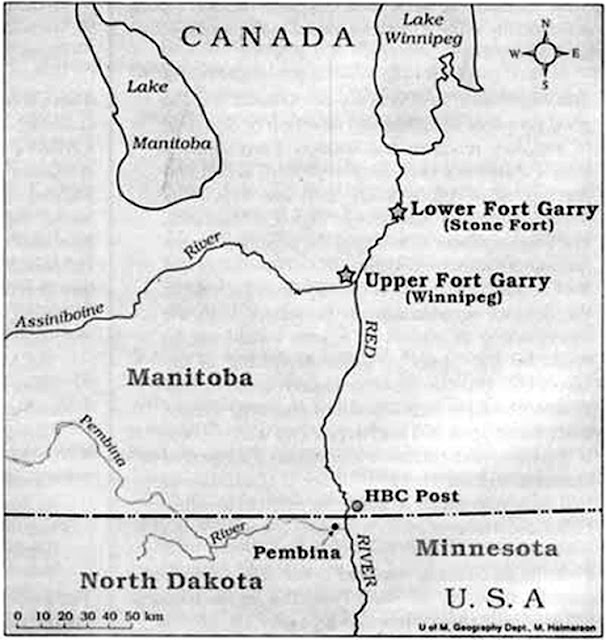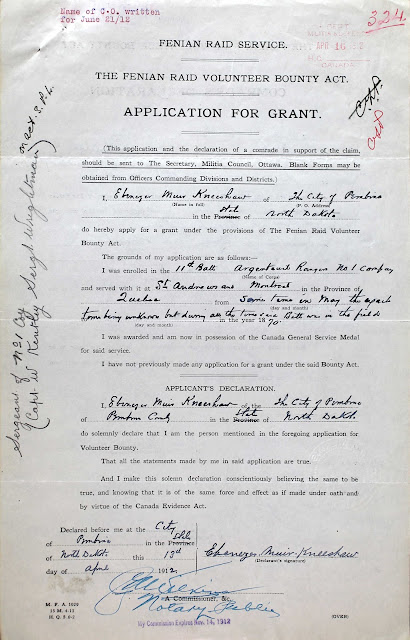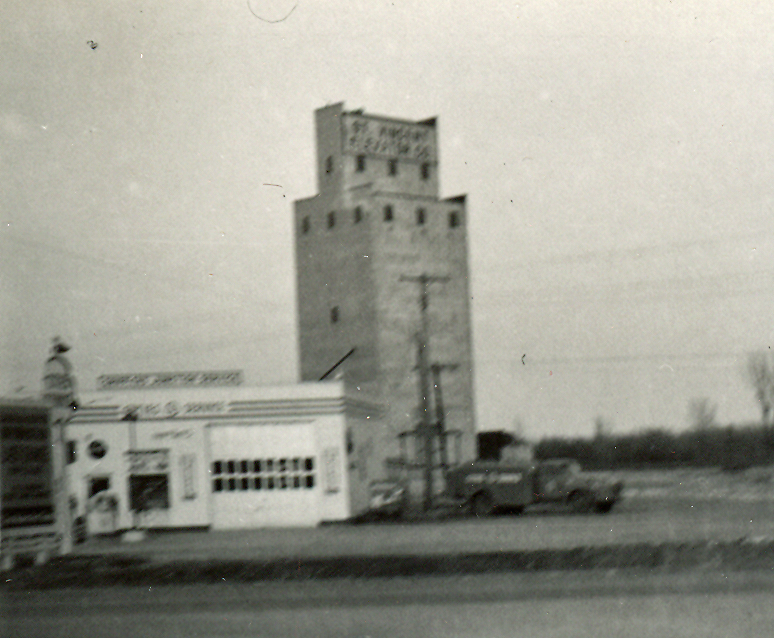St. Vincent Memories
Thursday, February 06, 2025
The History of the St. Vincent Weather Station: 1880-1892
Monday, November 11, 2024
Portrait: John Busha/Bushie/Boucher
 |
| John Boucher - Back row, on left (1855) |
Provision was made in the ninth article of the treaty of October 2, 1863 (aka Old Crossing Treaty), with the Red Lake and Pembina bands of Chippewa for a reservation of 640 acres of land for the Chippewa chief "Red Bear," to be located on the north side of the Pembina River. The agent reported that before he could make this selection, there was not a section of suitable land in one body remaining on the north side of the Pembina River for a long distance from its mouth, and he, therefore, made the selection on both sides of the river and reported it in that form. As this was not in accordance with the treaty, legislation by Congress was recommended in Office report of March 5, 1872, (H.R. Ex. Doc. 183,) authorizing the selection in this manner. Favorable action was not taken by Congress in the premises, and as such action is necessary in order to ensure to this chief the benefits contemplated by the treaty, Congress should be again be requested to legislate for his relief.
Boucher, John C. [*1868] ·P108.4d
Bushey, John [R.L. Scrip #331] ·
Bache, John [R.L. Scrip #331] ·
Pembina Annuity Roll, Mis co muh quah's Band, 1868:97 - 1 man, 1 woman $ 8 paid
Monday, March 27, 2023
PROFILE: Walter Hill (as Known by Kittson County Locals...)
Trish: Walter talked James J. into getting the first car the family had in 1905, but managed to wreck it by 1907.
He got married in 1908, and he was put in charge of the Northcote farm in 1910, so I'll go with that...
Time line - Walter got married in 1908, his wife is in the car. He wrecked the first car by 1907...(wonder what it was???)
So my guess-timate on the car at 1906-1908 wasn't too far off. I'll do a little research on the early Packard's to see if
I can determine an exact year.
Searching information on Minnesota license plates - the plate has to be a multi-year 1912 plate which had dark letters on
a silver background. The plates were good for three years so was valid 1912-1913-1914. All the earlier plates had dark
background colors.
But is it a Packard? The radiator emblem was always Packard written at a slant. Everything else is very similar to
a Model 30 Runabout.
I will agree with a 1910-1911 Packard Model 30 Runabout. The only thing is the radiator emblem. Did Hill have
a Vanity emblem made? Money was no issue. I can't find a close match to that emblem shape.
Windshield, top, headlights removed.
I was wondering if it might be an emblem for a fraternal order or auto club or ???? Front fender on the Hill car
seems a little flatter but that could have been a running change or model year change...
Walter loved speed, it is said his interests were tilted away from farming toward race cars. I' trying to identify the steamer
but they all look alike. I counted around 50 horses though.
This looks like it might be a source - I contacted the library as I couldn't get any access to the Motor Vehicle and
Driver License Registration Records, 1909-1921 Register of motor vehicles (1909-1914, with indexes), automobile
license applications (1921), chauffeur’s record (1909-1911), and motorcycle registration record (1909-ca. 1913).
MNHS call number: See the finding aid in the library (Secretary of State: Motor Vehicle Division).
There is so much I could find out if the Gale Library wasn't 300 miles away. Keep scanning folks!
Bernie: my Great Uncle George Hugill played base ball with Walter and said he would chase rabbits in a white
Stuz Bearcat. But that was 60 years later so maybe it was a Packard
Does anybody know if early Minnesota license registrations exist for these years?
Maybe this might help? https://libguides.mnhs.org/transport/automobiles
Probably a 1912 model - later than I first thought.1912, not much if any difference. 60 HP but Hill had a mechanic who could make it
Bernie Streed: My Great Uncle George Hugill was a contemporary friend of Walter Hill. What a character. During a
winter storm he started telling me stories of how they would chase rabbits across plowed frozen fields with a white
Stuz Bearcat convertible. He also told me he would order hand made oak barrels from Italy. Then he would stock the
milking barns with long horn steers. They would lock horns in the narrow milking stalls. The barns were state of the art
for the day, built with tile walls and sloping floors so manure could be flushed down trenches in the floor into the river
below. Basically the bored millionaire would roll these oak barrels down the center of the barn agitating the long horn
steers so they would kick the barrels to pieces. He and George would do this for hours till the barrels were gone. The
whole farm was meant to get James J Hill's playboy youngest son out of St Paul to reform him.
Trish: Walter Hill was a goer, or "someone vibrant for life." He hunted from his car, raced his draft horses in the streets of St. Vincent, and drank mightily. Before the fall harvest, he used to attach a hay-rack to the back of his car and go to Bronson, Minn., searching for labor. Men eager for jobs climbed onto the hay-rack and Hill drove them home in his usual manner. By the time he got back to the farm, there would be only one man left - the rest had jumped out along the way in fear for their lives.
Bernie: lol I can believe that. I know my Grandpa Bernhard Streed drove one of the steam tractors. He said he started in the dark of morning and made one swath to the Red River and back before sunset.
Keith Finney: I believe it was Byron or Marva that told me that he would go into Canada up by Tolstoi and get hired men. He would drive fast across the rough prairie and some would fall off on the way. Thus the illegal aliens that worked on the farm
Georgine Cleem Whalen: Thank you Trish for this wonderful information on Walter Hill and some of his escapades I see in one of the links that he passed in 1944 in the West which would have been during the time my Grandpa was working for him on the ranch he owned there in 1932. It became the Bishop Ranch in the 40's and I still remember them letting us swim in the pool as my mother worked for doc Bishop. It is not there anymore but they do have a street named Bishop place where this ranch set. I was wondering if Walter returned to Minnesota after my Grandpa Borgeson went to work for the shipyards along with his sons.
Trish this is how we 'Borgeson' family ended up in California. James Hill bought a horse ranch for Walter and my Grandpa Eric Borgeson went with him to work this ranch and property in 1932. The rest of the story is amazing how the whole family (13) left Mn. in a Franklin car and went west
I do not remember the name. I only remember after it became Bishop Ranch. I think my Mother said it was a horse ranch and her dad (Eric Borgeson) worked for Walter Hill and came to California in 1932. He sent for my grandma later and that's another wonderful story and they lived in the old red house there in Midway City, Ca. When my parents went to California in about 1942 sometime I was still the baby. We stayed at the old red house in the middle of a field just behind where the Hill place would have been. Shortly after my grandparents bought a place in Anaheim (this is where I lose track of Walter Hill about 1943/44) and my parents stayed at the old red house which was then bought my Hap Post who my dad worked for. We lived there till I was in high school when the property was sold by the Post Brothers. I digress here, the horse ranch that Walter Hill bought would be off Bolsa in Midway City, maybe considered Westminster at that time. I do remember this property as I got older. Walter Hill brought my grandpa a big old green rocking chair that is still in the family that all of us remember him rocking away in. Grandpa did change jobs at this time and I always wondered what happened to Walter Hill.
Monday, February 20, 2023
The Last of the Fenian Raids

Wednesday, December 21, 2022
Christmas Sunday School Memories
Friday, September 16, 2022
Humboldt-St. Vincent Elevator Association: End of an Era
This week, it was announced that the Humboldt-St. Vincent Elevator Association was being dissolved and thus the closing of the elevator in Humboldt, St. Vincent's elevator having closed some years before.1
Some of you may remember Silas Mathews who lived south of Humboldt. One summer afternoon in 1973, Silas and I were sitting on the railing going up the south driveway. It was a very quiet day. When we were visiting, a tandem truck pulled into the elevator with a load of grain. I unloaded the truck and returned to visit with Silas. For those who are younger, there were not that many tandem trucks before this time. Silas was kind of amazed at the size of the truck. I could tell he was in deep thought when I sat down on the railing to resume our visit. He then said, "You know Keith, with all of these big tractors and big trucks, farmers will soon be hauling all their grain to Crookston. There won't be many small farmers like today. They won't need this elevator any longer."That conversation with Silas never slipped my mind. I cherished every conversation I had with Silas. He passed away a couple years later...
In neighboring Emerson, a resident shared, "In the Emerson area in winter time, if you couldn’t see the St Vincent elevator, it was too stormy to be on the road!"
_________________
Wednesday, June 15, 2022
Fort Pembina Airport
- From Saga of Pembina County: 150 Years, by Jim Benjaminson ©2020
- Airport and Landing Fields in the United States, Bureau of Air Commerce (January 1, 1938)
Trivia: Buell Edwin Blake, who enlisted in the U.S. Navy in May 1937 right after graduating from high school. "He had a tattoo saying USN 1937-41...He was a Radioman2 3rd class at that time [during WWII]. Later went on to be an Air Traffic Controller in Pembina," said his son, Gary Blake.
[Buell would meet his future wife during this time - Jeanne Short, daughter of Gail & Eliza Short of Short's Cafe...]
2: Why did airliners of old require radio operators?
Wednesday, January 12, 2022
St. Vincent Grain Warehouses & Elevators


"The St. Vincent Elevator Company, a new farmers' organization, of St. Vincent Township, has bought the elevator and mill business of the St. Anthony & Dakota Elevator Company, which also includes the coal sheds, two dwellings, and two coal sheds at Sultan, the first station east of here on the Soo Line.
"The elevator, in addition to handling grain, will handle lumber and building material, also coal and seeds. Mr. Harry Ward Davis is the new manager."
It is evident from the news article at left, together with the other information earlier in this post, that the local farmers eventually realized they had to organize their own elevator to get the best prices they could for their grain. Their legacy is still going strong over a century later, with the Humboldt-St. Vincent Elevator Association...
Wednesday, October 13, 2021
Low Water: The Wreck of the Steamboat Dakota
Looking to see if anyone might know or have any more info on the story that might be behind this. As you all know the mighty red is far from mighty right now but I still decided to take my boat down to check things out. Came across what looked to be an old sunken boat of some sort. Brought it up to my dad and he said that his grandparents (Bud and Jean Feick) had said that it was an old steamboat that used to run from Forks to Winnipeg in the late 1800s but had gotten hung up and then just left in the river. They had also said that long ago you were able to see one of the masts sticking out of the water once the red would get lower. It sits about 3½ miles south of Pembina. Obviously most is completely covered with mud and/or missing but you can see about 30ft worth of deck right now. These boards are way bigger than they look in the pictures...
Paul Maloney: What do the nails look like, if any survived? And I think remnants of the boiler would still be there if it was a steamboat.
Jake Cosley: All the main nails used to hold the planks down are ¼x¼" square. There were a few large ½-⅝" round spikes used as well
Julie Lindegard: I will ask my dad Bob Cameron if he has any further info. Dad recalled hearing that Humboldt kids (St. Vincent kids were too far away) would often swim in the river and get on the boat and jump off. I can imagine it provided hours of entertainment for kids! He said that the Bockwitz family found and retrieved the anchor. They contacted my dad to take it to the museum in Lake Bronson at least 30 years ago. That's where it is now.
At Right: Evidence of scorched and burned decking could still be seen, over 140 years later...
Hetty Walker: Chuck always talked about the steamboat, that got hung up …that could be it
Janine Rustad: Talk to DeeDee Bakken---she used to say her dad knew exactly where it sunk
Julie Lindegard: Yes dad mentioned it was near/in the area of the Giffen farm.
Donald Burroughs: Does North Dakota have a historical society? Would be an opportunity to salvage some of the boat, those nails and boiler parts, paddle wheel hardware plus its coordinates to build a story around it.
Trish Short Lewis: They have already been contacted about this. State Historical Society of North Dakota's chief archaeologist, Andrew Clark.
Brandon Lee Legvold: Three (3) miles above Pembina it says which in Red River terms would be south of town so I would definitely say that is the hull of the Dakota that was found.
Trish Short Lewis: Since it’s only partially burned and witnesses say the ship burned, I think the idea of these being one of the two barges might be right. I reserve final judgment until we hear from DeeDee Bakken (hopefully) on what she recalls her father seeing…
 [Note from Trish: I later spoke with DeeDee and got some very interesting information from her! Also, the pump in the photo at left, was found by her, and then taken and donated to the Kittson County History Center & Museum, where it is today, along with the Anchor found many years ago by Humboldt's Bockwitz family...]
[Note from Trish: I later spoke with DeeDee and got some very interesting information from her! Also, the pump in the photo at left, was found by her, and then taken and donated to the Kittson County History Center & Museum, where it is today, along with the Anchor found many years ago by Humboldt's Bockwitz family...]Brandon Lee Legvold: [The source of the quoted newspaper article, which is pictured above, is...] the Worthington (Minnesota) Advance. August 19, 1880. Which oddly enough is today. I found this on Chronicling America.
Trish Short Lewis: Full reference citation for article is The Worthington Advance. [volume] (Worthington, Minn.) 1874-1908, August 19, 1880, Image 1 Image provided by Minnesota Historical Society; Saint Paul, MN (Chronicling America)
Jim Benjaminson: Preservation of the site is paramount.








.jpg)













